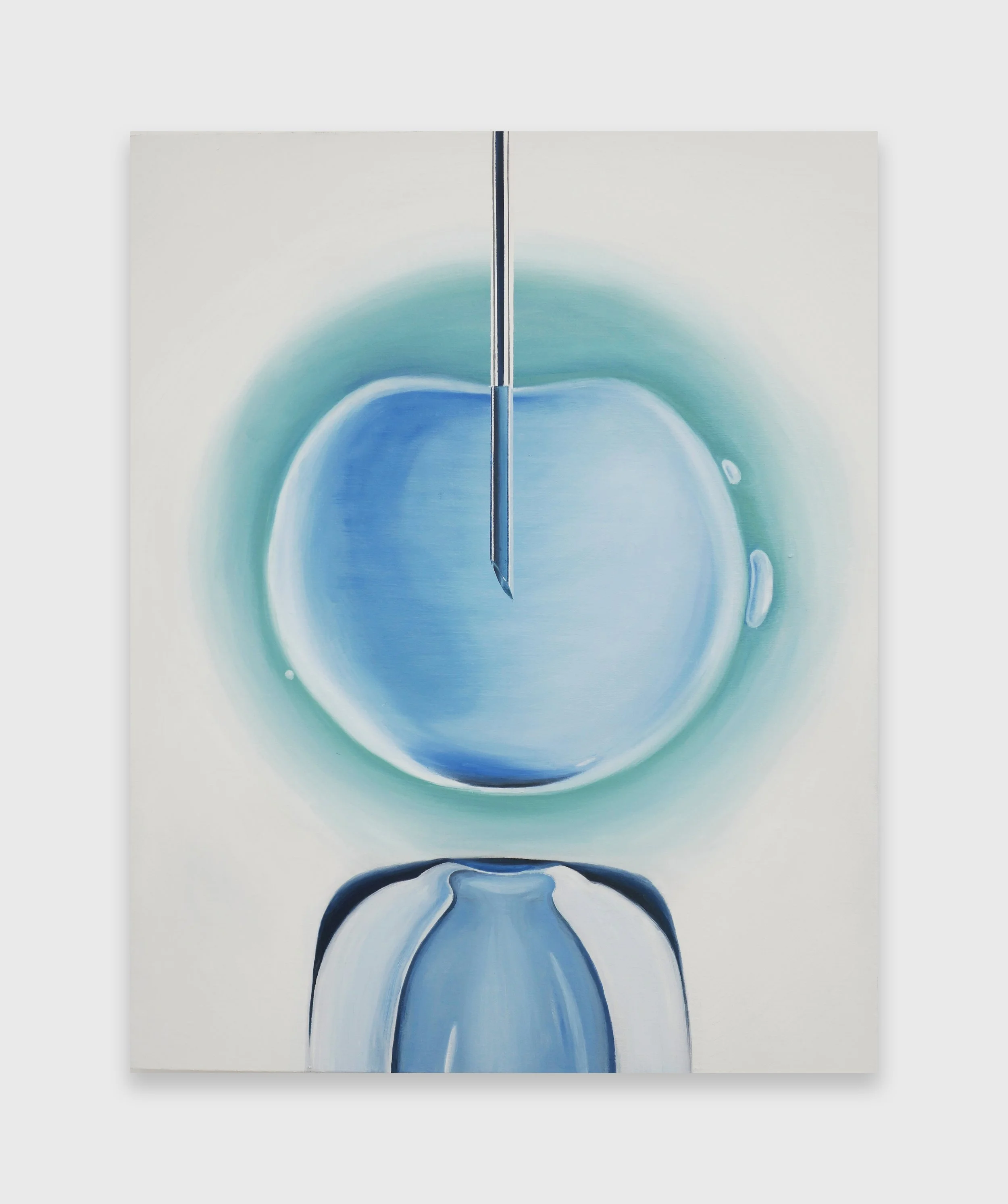IVF, 2020
IVF, 2020
Oil on linen
51 x 41 cm (20 x 16 in)
IVF (2020) captures the process of fertilization under a microscope, depicting a single sperm being injected into an egg through a central needle. The soft blue tones and precise positioning of the needle underscore the clinical and delicate nature of in vitro fertilization (IVF). IVF has a history spanning over half a century: in 1959, the first successful IVF birth in a nonhuman mammal was achieved, and by 1978, the first human baby conceived through IVF was born. Medical advancements have since transformed IVF from a natural research method into a controlled clinical treatment. For two decades, the concept of using artificial intelligence-enhanced supercomputers for DNA editing in fertility treatment has been explored to determine which options are most likely to result in a live birth. This technology has now expanded beyond infertility treatments to include non-medical applications, such as genetic optimization and gender selection. In the context of global health crises and the commodification of genetic engineering, IVF raises questions about which conditions are deemed “screenable” and examines concerns surrounding genetic stratification and social inequity.
Q: What inspired you to create IVF?
Tan Mu: The inspiration for IVF came from the scientific process of in vitro fertilization (IVF). Initially, it stemmed from my reflections on fertility and egg freezing. As I delved deeper, I learned that genes could be selected and even edited, and I began researching the technical and ethical aspects of these procedures. High-quality sperm and eggs can be selected, and sperm banks provide portfolios detailing donors’ backgrounds, from personal education and physical health to the genetic history of parents. These profiles resemble a collection of “perfect” genes for clients to choose from. This also reminded me of the film Gattaca and its depiction of a future genetic society. I became particularly interested in how these technologies deal with the microscopic aspects of life and the contrast between what is visible and invisible.
Q: You mentioned that IVF technology inspired your reflections on genetic optimization. Could you elaborate on that?
Tan Mu: Similar to plastic surgery, IVF technology was initially developed to address infertility or to screen for genetic diseases. However, its evolution has gone beyond “fixing defects” to include embryo optimization, such as selecting for gender or enhancing genetic traits. Genetic screening is increasingly becoming a consumer product rather than a purely medical tool. At the same time, it raises significant ethical concerns—will genetic editing lead to further societal stratification or the commodification of “designer babies”? These technologies could potentially deepen inequality and elitism. In my work, I try to express these concerns. While technology offers hope, it also challenges our notions of equality and the natural diversity of life.
Q: Many of your works portray technology as an extension of the body. How do the microscope images from labs provide you with a unique perspective?
Tan Mu: Microscope imagery opened up a microscopic world for me, and the structures and forms I observed resonated with my reflections on the essence of life. From the shapes of cells to the stages of embryonic development, I saw a profound sense of potential and uncertainty in life. I translate these scientific images into abstract forms—not to replicate them but to create a dialogue between science and art. These images make me think about how technology, on a microscopic level, shapes and controls life, while also deepening my sense of awe at the fragility and complexity of existence.
Q: Could you talk about the colors and composition of this piece?
Tan Mu: In IVF, I predominantly used cool blue tones to convey the clinical calmness and neutrality of the laboratory environment while also evoking the purity of life’s earliest stages. The composition contrasts vertical needles with the rounded shapes of cells. The needle symbolizes the power of technological intervention, while the rounded cells represent the softness and potential of natural life. This contrast emphasizes the tension between technology and life, inviting viewers to consider how we perceive the power and limitations of technological intervention in life’s earliest stages.
Additionally, I was struck by the stark contrast between the microscopic size of sperm and the massive scale of eggs—an egg, as the largest single cell in the human body, is visible to the naked eye, while sperm requires microscopic technology to be observed. I wanted to render this scientifically significant disproportion visually dramatic and philosophically profound in my work.

